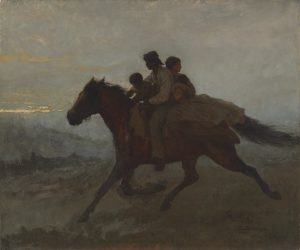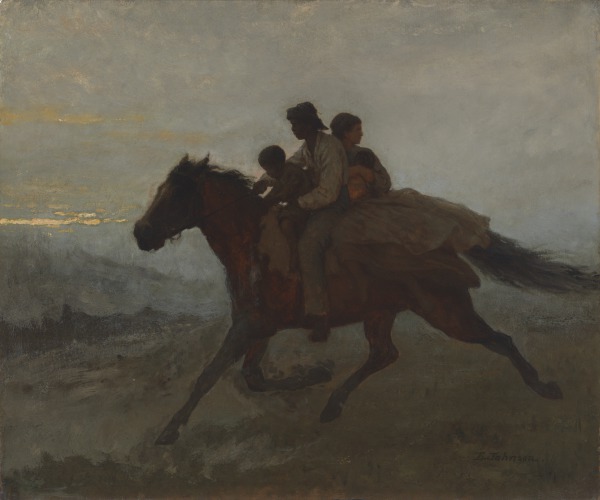
Lesson Concept: Eastman Johnson
Students can explore issues such as slavery and the Civil War by using Eastman Johnson's painting as a primary source of history.
Object & Artist Information
This painting is by American artist Eastman Johnson (1824–1906), who began his career in the printing business. In 1845 Johnson moved to Washington, D.C., where he created portraits of well-known people in chalk, crayon, and charcoal. He went to Europe in 1848 to study painting and returned to America in 1855. He became widely acclaimed for his genre paintings, or scenes of everyday life. During the Civil War, many of his paintings focused on African American subject matter, particularly slavery, the critical issue of the time. Traveling with the Union army, he recorded events and battles he witnessed.
Johnson completed A Ride for Liberty—The Fugitive Slaves in 1862, a year after the Civil War began. It depicts an enslaved African American family—father, mother, young boy, infant—fleeing on horseback. As the title notes, this enslaved family is attempting a daring escape to the Union army lines. On the back of the painting, Johnson wrote: “A veritable [true] incident/in the Civil War seen by/myself at Centerville/on this morning of/McClellan’s advance towards Manassas March 2, 1862/Eastman Johnson.” The painting and inscription serve as a primary source of an historical event. Johnson painted three versions of A Ride for Liberty, but only two are known—this one and another in the Brooklyn Museum’s collection. Apparently, they were never exhibited during Johnson’s lifetime, perhaps due to the charged subject matter.
Activities
ACTIVITY 1
Ask the students to pretend to be one of the characters in the painting and complete the following sentences, as that person would:
My family and I are traveling to…
When I get there I will…
To me freedom is…
ACTIVITY 2
Have students choose a character from Eastman Johnson’s A Ride for Liberty—The Fugitive Slaves and develop a short narrative about that person, based on what they observe in the painting and by using their imaginations. Students could write about the character’s past, present, future, or summarize the character’s entire life. Next, ask the students to select a favorite scene, illustrate it, and give a title to their story and drawing.
Encourage the students to share their ideas about what they produced!
Standards of Learning
Visual Arts: 4.1, 4.3, 4.13, 4.20, 4.21, 5.1, 5.2, 5.12, 5.19, 5.21, 6.15, 6.17, 6.18, 7.3, 7.14, 7.18, 7.20
History: VS.1 a,c,d,e,f, USI.9
English: 4.1, 4.7, 6.6, 7.8

